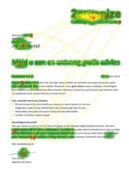The previous post introduced readers to a big idea:
Successful direct mail appeals tend to be written to communicate the main message in a) just the areas a donor is likely to see as they glance at your letter, and b) in the letter as a whole.
Why? Because a large percentage of your donors will just glance at your letter and make a decision for whether to give – or not. And you want your letter to be effective for both “Glancers” and for people who read the whole thing.
So how do you write a letter that works for Glancers and Readers?
It looks something like this:
- The top-center or top-right corner of the letter contains a short blurb about the Need or about what the donor’s gift will do to help.
- The first three-ish paragraphs tend to summarize the whole letter. They share why the donor’s gift is needed, what the donor’s gift will accomplish, and ask the reader to send in a gift today.
- The middle section of the letter tends to go more in-depth. It shares more details about why the letter is being written, perhaps shares a story that illustrates the need for the donor to take action, and shares a bit more about what the organization does in situations like this.
- The last couple of paragraphs tend to repeat what was said in the first three paraphs.
The Result
This results in a letter that “makes the whole case” in just the first few paragraphs. This ensures that almost anyone who picks up the letter will know what it’s about – which results in more gifts. Think of it as making half of your donors understand more about what their gifts help do – who wouldn’t want to make that improvement?!?
This results in a letter that can sound repetitive to internal audiences because it repeats the main ideas in a couple places. But the vast majority of donors (the audience for the letter!) don’t experience the letter this way. To donors, it sounds like a focused letter about something they care about.
This results in a letter that doesn’t “sound like us” – because if you’re going to summarize the whole case in three short paragraphs you don’t have time to talk the way the experts in your organization normally talk. But remember, if your letter doesn’t “sound like you” I think you should experience “not sounding like you” as a positive, not a negative.
Your Next Letter
The next time you write and design a letter, first go look at the heat map. Remind yourself (and anyone involved with approving the letter) that you’re writing two letters in one.
If you can make your letter work for both Glancers and Readers, you’ve done a great service to your organization and beneficiaries.
How? Because you’ve lowered the barrier to giving a gift. Instead of requiring a person to read the whole letter to know what you’re writing about, you’ve made it possible for Glancers to know – in just a heartbeat or two – why you’re writing them today and what they can do about it.
Do that and a surprising number of Glancers will send you a gift.
And your regular Readers will still send you their gifts.
You will raise more money and do more good.
You will have sent 2 letters in 1.
Steven Screen is Co-Founder of The Better Fundraising Company and lead author of its blog. With over 30 years' fundraising experience, he gets energized by helping organizations understand how they can raise more money. He’s a second-generation fundraiser, a past winner of the Direct Mail Package of the Year, and data-driven.









2 comments on “Two Letters in One”